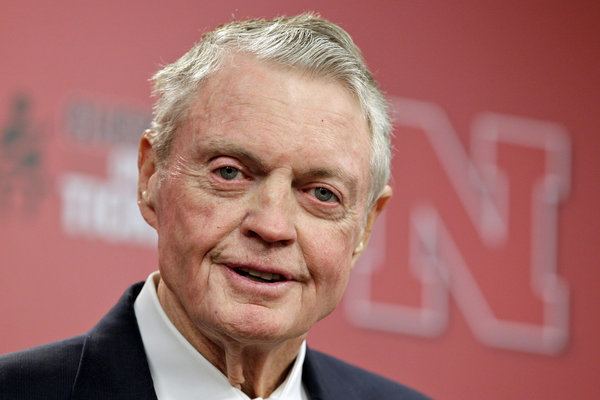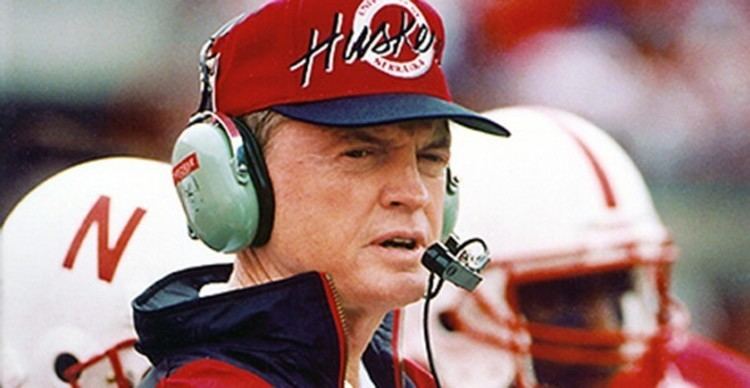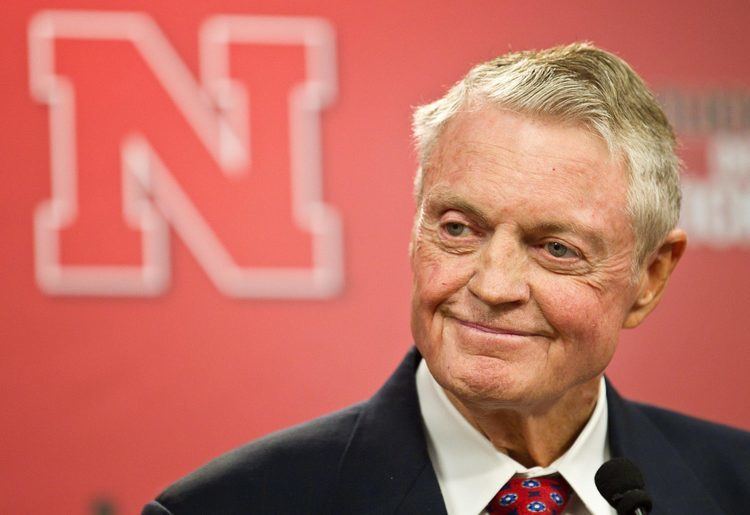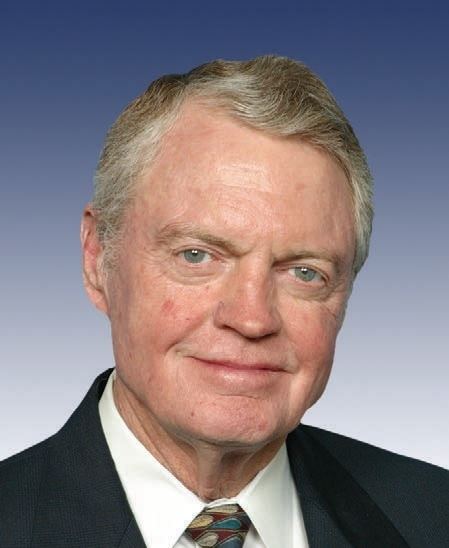Sport(s) Football Name Tom Osborne Spouse Nancy Osborne (m. 1962) | Resigned January 3, 2007 1960–1961 Washington Redskins | |
 | ||
Role Former U.S. Representative Movies Tom Osborne's Nebraska Cornhuskers Books Beyond the Final Score: Th, Secrets to Becoming a Leader, On Solid Ground, Over the Edge, Shatel Similar People | ||
Tribute to tom osborne
Thomas William Osborne (born February 23, 1937) is a former American football player, coach, college athletics administrator, and politician from Nebraska. He served as the head football coach at the University of Nebraska football team for 25 years, from 1973 to 1997. Osborne was one of the most successful coaches in American college football history, with a career record of 255–49–3, 13 conference championships, and three national championships. He was inducted into the College Football Hall of Fame as a coach in 1999. Osborne was later elected U.S. Representative from Nebraska's 3rd congressional district, as a Republican. He served three terms, from 2001 to 2007. In 2007, he returned to the University of Nebraska as athletic director (AD). He retired as AD in January 2013.
Contents
- Tribute to tom osborne
- UCF Kickoff Luncheon talk featuring Dr Tom Osborne about life adversity and integrity
- Early life
- Playing career
- Coaching career
- Head coach at Nebraska
- Honors
- Coaching tree
- Athletic director career
- House of Representatives
- 2006 governors race
- References

UCF Kickoff Luncheon talk featuring Dr. Tom Osborne about life, adversity, and integrity.
Early life

Born and raised in Hastings, a small town in rural central Nebraska, Tom Osborne was a star athlete at Hastings High School in football and basketball, and won the state discus throw in track. As a senior in 1955, he was awarded the Nebraska High School Athlete of The Year by the Omaha World Herald. He then stayed in town to attend Hastings College, the same college his father and grandfather had attended. During his time at Hastings College, Osborne played football and basketball. He graduated with a B.A. in history in 1959, and was awarded the Nebraska College Athlete of the Year. Osborne was drafted into the National Football League (NFL) by the San Francisco 49ers, for whom he played one season as a wide receiver, before playing two seasons for the Washington Redskins.

Osborne earned a M.A. in educational psychology from Nebraska in 1963 and a doctorate in educational psychology there in 1965. He also served in the Nebraska Army National Guard from 1960 to 1966.
Playing career

He attended Hastings College, where his grandfather, class of 1901, and father, class of 1930, graduated. He was in the class of 1959, quarterbacked the football team and became the first male athlete in Nebraska to win both the high school (1955) and college (1959) athlete of the year awards by the Omaha World Herald. Osborne played three years of pro football as a wide receiver for Washington and San Francisco.
San Francisco
Tom Osborne began his NFL career on January 21, 1956 when the San Francisco 49ers drafted him in the 19th round of the 1956 NFL Draft in Philadelphia with the number 222nd pick. It was during the Mineral Water Bowl in 1954, in Excelsior Springs, Missouri, that a brother of a scout for the San Francisco 49ers spotted Osborne. Osborne and Hastings College had beaten College of Emporia 20-14. The legendary Nebraska head coach's first bowl appearance was in 1955 as a freshman quarterback. He was eventually cut from the 49ers without playing.
Washington
The Washington Redskins picked up Osborne in 1960. He made his debut on November 6 against the St. Louis Cardinals. Osborne had one reception for 8 yards, however it would be the team's third loss of the season, 44-6. In Tom's second career game, which took place on December 4 against Cleveland Browns, Osborne racked up 36 yards on 6 receptions, even so the Redskins went on to lose 27-16.
Osborne saw more playing time in 1961, starting play in twelve games that year. His best was arguably on December 3 against the St. Louis Cardinals where he racked up 75 yard on 2 receptions both for 37.5 yards a reception. Osborne never made the playoffs as a player.
Coaching career
In 1964, Osborne joined the Cornhusker coaching staff as an unpaid offensive assistant to head coach Bob Devaney; his only compensation was being able to dine at the athletic training table. After two disappointing 6–4 seasons in 1967 and 1968, Devaney named Osborne as offensive coordinator for the 1969 season. Osborne immediately overhauled the offense, switching to a balanced attack operated from the I formation. The revamped offense sparked the 1970 Cornhuskers to the national title. The Huskers defeated LSU, 17–12, in the 1971 Orange Bowl and finished first in the post-bowl AP Poll, but third in the final UPI Coaches Poll. Through the 1973 season, the final UPI coaches poll was released before the bowls, making it a "regular season" title. The UPI awarded its title to Texas, which lost to Notre Dame in the Cotton Bowl. Second-ranked Ohio State also lost, to Stanford in the Rose Bowl. Nebraska was 13–0 in 1971 and a consensus national champion, defeating the next three teams in the final AP Poll: Oklahoma, Colorado, and 1971 Alabama.
Devaney announced he would step down as head coach at age 57 after the 1972 season to concentrate on his duties as athletic director, and named Osborne as his successor. Following a convincing win over Notre Dame in the 1973 Orange Bowl, Nebraska's third straight Orange Bowl victory, Osborne, age 35, took over as head coach. He was head coach for 25 seasons, through the 1997 season, serving for most of that time as his own offensive coordinator.
Head coach at Nebraska
In his quarter-century as head coach, Osborne was a model of consistency. His teams never won fewer than nine games in a season, only finished worse than third in conference or division play once, finished in the top 15 of the final AP poll 24 years out of 25 (having finished 24th in 1990), and were ranked in every single weekly AP poll barring one week in 1977 and two in 1981. Osborne's teams won outright national championships in 1994 and 1995, and a share of another in 1997. Osborne's Huskers also won or shared 12 Big Eight Conference titles and one Big 12 Conference title. His 255–49–3 record gave him the best winning percentage (83.6%) among active NCAA Division I-A coaches at the time of his retirement and the fifth-best of all time. As of 2006, only Joe Paterno of Penn State has reached 200 victories in fewer games. But Osborne, who went on an NCAA record 60–3 run over his final five seasons, won 250 games faster than any coach in Division I-A history. Osborne finished his coaching career with a bowl record of 12–13.
Osborne's teams were known for their powerful rushing attack and strong defense (also known as the Blackshirts—referring to the black jerseys that are worn in practice by the defensive starters and certain selected special teams players). Nebraska led the nation in rushing several times in the 1980s and 1990s, due to the efforts of men like Jarvis Redwine, Heisman Trophy winner Mike Rozier, Calvin Jones, Ahman Green and Lawrence Phillips. After struggling to defend Oklahoma's wishbone option in the 1970s, Osborne switched from a balanced attack to a run-based option offense in 1980 in order to utilize the versatility of dual-threat quarterbacks, such as Jeff Quinn, Turner Gill, Tommie Frazier, and Scott Frost.
Entering the 1984 Orange Bowl, the 1983 Cornhuskers were 12–0 and ranked #1 in the country for the entire season. Nebraska scored a late touchdown against the #5 ranked Miami Hurricanes to narrow the score to 31–30. Rather than attempt an extra point to tie, Osborne opted to attempt the two-point conversion and go for the win. However, Gill's pass attempt was tipped away in the end zone, giving hometown Miami the victory and the national championship.
In 1993, the Huskers again narrowly lost a national championship. Having gone into the 1994 Orange Bowl as a 17-point underdog to Florida State, Nebraska fought back from a 15–7 deficit to take a 16–15 lead with less than two minutes remaining in the Orange Bowl. After Florida State drove to retake the lead 18–16, Nebraska managed to hit a quick downfield pass in order to get one last field goal attempt as time ran out, which sailed wide. It was the last bowl game Osborne ever lost. The next year, however, Osborne earned his first title as head coach, defeating Miami in the 1995 Orange Bowl. The Huskers, who initially trailed, rallied to win 24–17. The next year, the Huskers roared through the regular season, stayed atop the rankings for all but one week, and crushed the Florida Gators, 62–24, in the 1996 Fiesta Bowl, earning Osborne his second national championship. The 1995 team was voted as the greatest college football team of all time in an ESPN poll. Osborne announced his retirement as head coach late in the 1997 season, selecting Frank Solich, his longtime running backs coach, to succeed him. In his final five seasons, Osborne's record was a staggering 60–3 (.952), at the time the strongest finale to any coaching career in NCAA football history and still a major-college record, though since surpassed by Larry Kehres' record of 72–3 (.960) in his final five seasons at Division III Mount Union from 2008 to 2012. His final game as head coach came in the 1998 Orange Bowl with a 42–17 victory over Tennessee, also the final NCAA game for Tennessee quarterback Peyton Manning.
Honors
Osborne was inducted into the College Football Hall of Fame in 1999, and in 2000, he received the Jim Thorpe Lifetime Achievement Award. In 1999, ESPN honored Osborne as the coach of the decade for the 1990s. In a 2007 online ESPN poll, Osborne was voted the "greatest college football coach of all time".
In 1998, Nebraska renamed the playing surface at Memorial Stadium Tom Osborne Field in Osborne's honor. The stadium had almost doubled in size during his three decades on the coaching staff, reflecting Nebraska's increased national prominence in that time.
Coaching tree
Assistant coaches under Tom Osborne who became NCAA head coaches:
Athletic director career
From 1979 to 1998, Osborne was assistant athletic director at Nebraska, first under Bob Devaney then under Bill Byrne.
Osborne and the 1997 national championship team were the guests of honor at the Huskers' 2007 Homecoming game on October 13. Just two days after the resulting 45–14 loss to Oklahoma State – Nebraska's worst home loss since being shut out 31–0 by Missouri on November 1, 1958 – athletic director Steve Pederson was fired. On October 16, 2007, Osborne was announced as the interim athletic director, following Pederson's departure. On November 24, 2007, Osborne fired head coach Bill Callahan following a 5–7 season. Osborne appointed himself interim head coach so that he could perform recruiting duties while remaining in compliance with NCAA rules. He served as interim head coach for almost a week until naming Bo Pelini as head coach on December 2. In 2010, Osborne ended Nebraska's long-standing relationship with the Big 12 Conference and accepted an invitation for Nebraska to become the twelfth member of the Big Ten Conference.
On December 19, Nebraska removed the interim tag from Osborne's title and announced he would remain as athletic director through June 30, 2010. Osborne was paid $250,000 per year and managed Nebraska's 23-sport program. Osborne later agreed to continue as athletic director after 2010, with his position to be reviewed annually. On September 26, 2012, Osborne announced his retirement as athletic director, effective January 1, 2013. Osborne officially resigned on January 2, 2013, after returning to Lincoln with the Huskers football team following their participation in the Capital One Bowl.
House of Representatives
Early in 2000, Osborne announced that he would run in Nebraska's 3rd District as a Republican. He had grown up in Hastings, one of the larger cities in the sprawling district, and claimed a home in Lemoyne, near Ogallala, as his district residence. However, he hadn't lived regularly in what is now the 3rd since at least 1964; for most of that time he'd lived in Lincoln, the heart of the 1st District. Nonetheless, due to his wide popularity in the state, he easily won the Republican primary, which was tantamount to election in what has long been one of the most Republican districts in the nation. He breezed to victory in November with 83 percent of the vote. He was reelected with no major-party opposition in 2002 and against an underfunded Democrat in 2004.
In Congress, Osborne's voting record was moderate to conservative. He garnered a lifetime rating of 83 from the American Conservative Union.
At one point, Osborne teamed up with Nebraska State Senator Ernie Chambers, normally his political adversary, to oppose efforts to expand gambling in Nebraska.
2006 governor's race
In 2006, Osborne ran for Governor of Nebraska, challenging Governor Dave Heineman and Omaha businessman Dave Nabity in the Republican primary.
Osborne was initially thought to be the favorite in the race, given his tremendous popularity in the state. However, Heineman took 49 percent of the more than 197,000 votes cast while Osborne took 45 percent.
The Lincoln Journal Star analyzed the race:
While Osborne captured populous Omaha and Lincoln, Heineman sealed his victory in rural counties and key population centers in western and central Nebraska’s critical Republican battleground....
...it was the political impact of two gubernatorial vetoes that appeared to lift [Heineman ] into a late surge, especially in Osborne’s congressional district.
Heineman’s opposition to Class I rural school reorganization and the granting of resident college tuition rates to the children of illegal immigrants cut into Osborne’s support.
Osborne declined to sign referendum petitions seeking voter repeal of the rural school legislation and said he would have signed the resident tuition bill." [1]
